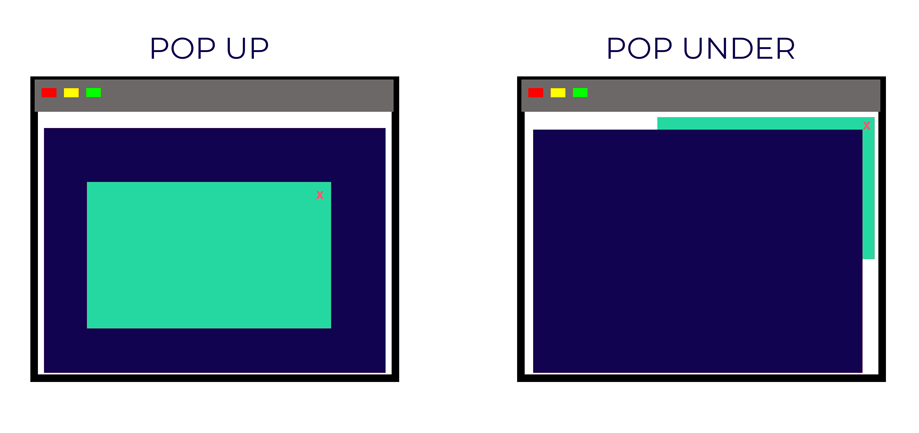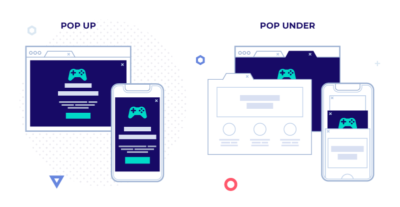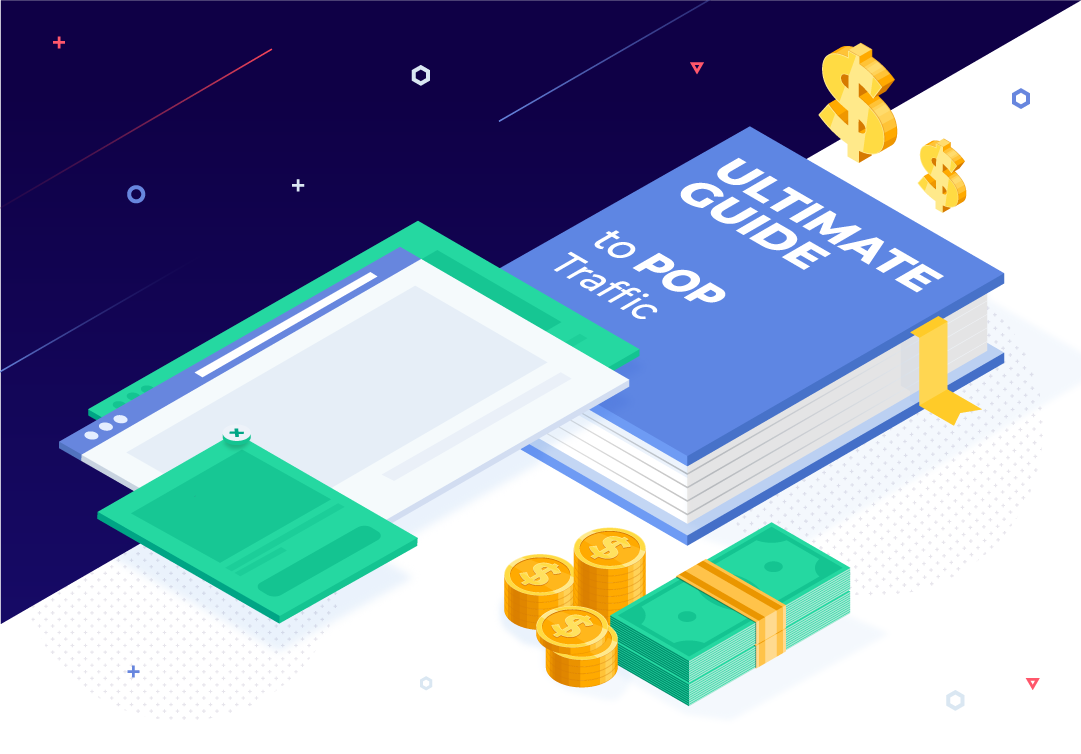Ethan Zuckerman once said that “advertising is the original sin of the web”. Now, this might not sound too surprising until you come to the realization that Mr. Zuckerman is in fact the man who created pop ads.
You may dislike them, even fight them, but at the end of the day, you simply have to live with them. That’s because there’s no question that pop-ups and pop-unders are still an efficient type of advertisements, commonly used by websites to help monetize their traffic or content. Even though some have pronounced it dead, pop advertising is still very much alive and well in 2022.
Read to learn what’s the difference between pop up and pop under ads, what are the benefits of using pop advertising, and how come pop ads work perfectly fine after so many years in the business.
A brief history of pop advertising
Pop-up ads first came to life in the 1990s from Zuckerman’s idea to implement an ad that would open in a separate browser window, rather than be displayed in the form of banner ads.
The main idea behind coming up with something new was that banner ads, when displayed on a given page, could imply a connection between that page’s content or site information and the advertised brand. And that’s how a brand new ad format was created — pop ads.
To this day, we tend to call this form of advertisement pop advertising. But as the years followed, new variants were created to answer the market’s needs — pop-up and pop-under ads. While pop-ups are displayed on top of the websites you’re visiting, the difference for pop-under ads is the windows are opened in the background. You can see them when you close your current browser window or site.
Both pop-up and pop-under ad formats are quite cost-effective traffic sources. Pop ups gather users’ attention as soon as they are displayed, whereas pop unders can (but don’t have to) serve as a kind of a remarketing tool. Users usually take notice of them when they leave the website or shut down their browser.
The benefits of popup and popunder ads
An alternative to display ads
In an ever-monopolized advertising market, popup ads provide a refreshing alternative to display ads, SEO, Google ads, email, and social traffic.
Even though pop ads constitute just about 2% of all online advertising, statistical information proves that they are a niche worth investing in. On average, popup ads’ CTR is 6 times higher than that of banner ads! This means that if an ad on the web page gets clicked 5 times per 1000 impressions, a pop ad would score 30 clicks. That’s a world of difference.
To help explain the high efficiency of pop up ads, it’s useful to revisit the term banner blindness.
In a nutshell, with more and more ads being displayed online, our eyes subconsciously ignore banners and their lookalikes on websites or currently viewed browser window. But it is difficult to miss an ad when it covers the web area or site. That’s why visibility is the key advantage when it comes to pop advertisements.
Nowadays, every big ad network such as Zeropark or Propeller Ads offers pop up and popunder traffic. Next to push notifications this is a standard for every self-service platform and it’s a form of advertisement highly recommended for media buying beginners.
The versatility of usage
Another advantage of pop ads is their versatility. They can be programmed to trigger depending on a user’s activity on various websites. They can pop out when users attempt to leave a website, switch pages, or when they click on a designated area of a site. Pop-up and pop-under ads can be utilized both for desktop and mobile browsers. Whenever users open a new browser or a new web page, popups can be shown.
High conversion rates and ROI
Such flexibility and smart mixing of pop-ups with pop-unders give great opportunities for both publishers and advertisers to increase their profits.
The travel e-commerce giant Booking.com can serve as a good example of the thoughtful use of pop-under advertising for its page. When you select and proceed with a hotel reservation, but ultimately don’t make the booking, a new window may appear beneath your main browser screen with accommodation offers for the exact same dates and a similar pricing range you were interested in with your original search.

The drawbacks of pop ads
Obviously, there are some drawbacks to pop advertising too. For starters, they require a financial investment in the beginning, to see what campaign configuration brings the best results. In the long run, however, pop ads prove to be more cost-effective than banners.
Some publishers believe implementing pop up ads might lead to the potential loss of visitors on their page. But that’s not necessarily true.
Not all pop ads are equal
Remember all these sites filled with display ads, using flash or other rich media, or distracting autoplaying video ads?
Not only do they slow down the speed of the website, but they are also super annoying for visitors too. So, in defense of popunder and pop ads, some traditional ad types can be even more intrusive and distracting. But as with any ad type, the implementation of pop-ups has to begin with a test phase to determine what frequency is optimal and what activity on the website should trigger the pop-up/popunder.
The Good, the Bad, and the Ugly
There is no denying that as a visitor, you would rather not have website content obscured by ads. On the other hand, thousands, if not millions of streaming sites wouldn’t even exist if it weren’t for pop ads being their key source of income. Pop ads are there, so you can watch your team’s games or catch up on your favorite show for free.
But if you still fear that your visitors might lose interest in your website because of the ads popping out at them, pop-unders can prove to be a great alternative.
Research by Webglide shows that popunders don’t really affect the user experience. The number of sessions, page views, and visit duration are all pretty much the same when a pop-under window is issued compared to when it isn’t.
The most significant obstacle in pop advertising, however, is developments in browsers and menu bars.
Since around 70% of internet users complain about pop-ups, browser developers have taken steps to block them. The first one to introduce such a solution by default was Opera, but their competitors, like Firefox and Chrome, soon followed suit. This doesn’t mean, though, that these have completely stopped publishers from displaying pop ads.
Learn all you need to know about pop traffic
Read the ultimate guide to pop advertising!
How has pop advertising changed over time?
Pop-ups have come a long way since their inception in the ‘90s. Nowadays, most of the pop-ups you encounter are interstitials or hover ads with the occasional appearance of highlighted links (injection ads). Both ad types expand over the majority of a website but do not open in a separate, new window. This makes it difficult for browsers to block them, hence their popularity among advertisers. In the ongoing development of browsers and pop ad formats, traditional pop-ups and pop-unders have become an underrated form of advertisements.
Traditional pop ads still appear on certain, high-traffic kinds of websites (like video streaming or adult sites) as well as on mobile devices. Don’t be surprised to see some big brands, like Porsche, Uber, or Facebook, advertising this way. It’s a common tool of pitching a brand to a user, and it could bear a great value – for example as an infographic (creating these isn’t too complicated as well, for example with an infographic maker)
Also, popups and popunders are a big hit with e-commerce offers.
Moreover, there are some well-known companies (like Orbitz, to name just one) for which pop advertising has been the cornerstone of their marketing and the fundamental of their online business. Finally, promoting offers that are relevant to the content of the website (like betting offers on sports streaming sites) makes those ads more interesting for the visitors.
What’s more, mobile pop ads are growing more popular. These are not only pop-ups and pop-unders that show up in the browser window on your phone or tablet but also in-app ads. Usually, the idea behind those ads is to promote and invite the user to install an app. The conversion ratio of such campaigns is usually very high, and usually, there’s no need to create a landing page.

How pop up and pop under ads work?
When opening the gates to pop ads, you should remember to partner with secure ad exchanges or a traffic source that monitor their campaigns both automatically and manually.
Best popup ad network
Zeropark, for instance, has a dedicated team of people to additionally control the content of campaigns to block anything harmful, malicious, or aggressive. It is of utmost importance to cooperate with the best networks/exchanges/traffic sources that are strict in regard to scams, malware, ransomware, auto-downloads, inappropriate and other harmful content.
No matter if you’re an advertiser or a publisher, when you have already chosen your partner, it’s useful to know the basics of pop advertising mechanisms.
When setting up pop ad campaigns, you will see some settings that should look familiar if you have done other online advertisements before. Some factors may require some extra attention, though.
Pricing models
First of all, the pricing. Different ad exchanges may rely on different models for popup and popunder ads. Whether it’s CPM (Cost Per Mile), CPV (Cost Per View), CPA (Cost Per Action) or any other, make sure you know how they differ and take this into consideration when providing your bid rate.
Targeting
Secondly, targeting. Understanding your audience is the key to effective ad targeting, relevancy and future campaign cost efficiency. Specifying a geo, connection type, OS, browser, and device type all make your campaign more precisely targeted, which may lead to more conversions and obviously limits the advertising spend.
Optimization
Remember about testing different traffic sources, and optimize your campaign by pausing the traffic from the sources that don’t convert well. For publishers, it’s important to properly describe the contents of your website with keywords so the user-base will receive adverts directly related to their interests. Additionally, draft guidelines for ad exchanges to help them deliver ads you’re okay with.
Thirdly, frequency capping. Since pop ads (especially those irrelevant to their context) can be annoying for the visitors, it’s best not to risk turning the audience away from your product. So when setting up your campaign, you should tool around with capping the impressions served to the same groups of visitors at – let’s say – 2 or 3 times per day. This serves not only the recipients but also yourself, as it will prevent you from throwing your money away on users who won’t interact with your ad.
Ad blocking
And last, but not least, it’s important to note that if a pop-up gets triggered, but the recipient doesn’t see it because it is blocked by the browser, proper platforms will not count it as an impression, ultimately eliminating advertisers’ risk and waste of budgets.
Luckily, gone are the days of just hiring a bunch of people to handle advertising manually for you. Nowadays, there are self-serve platforms on which you can set up your campaign and costs. The rest is done automatically, based on RTB.
Real-Time Bidding
RTB, short for real-time bidding, is a quick auction, allowing advertisers to bid for an impression of an ad. It starts as soon as a visitor attempts to load a website, and the process ends within just about 70 milliseconds, which is significantly faster than a blink of an eye.
Such a form of advertising allows advertisers to spend their money more wisely, as they are bidding for a specific impression, rather than a package of random recipients of an ad. This way, they can make sure that each impression of their ad aligns with their target.
From the publisher’s point of view, RTB is also beneficial as it allows them to sell otherwise unsold inventory, while also setting up a price floor. Traditional pop ads are an excellent opportunity to expand inventory, as, contrary to banners, they do not take up any space on the website.

Are pop ads still effective?
If you use pop advertising wisely, it’s proven to be an immensely effective way to boost your business. Still influenced by the experience from 15 years ago, performance marketers may be skeptical about pop ads (meaning both pop ups and pop unders), and that’s why this form has become quite a niche in online advertising.
Yes, you might hear all about social media traffic, Facebook ads, email marketing, and so on. An average internet user in the 21st century will see an ad over 5,000 times a day. Digital marketing is saturated with so many adverts, you can place them and see them just about anywhere.
But when every best ad network around has an article on the benefits of pop up and pop under ads, can you really afford not to take advantage of them?
Can a pop-under ad be effective?
If you’re worried that pop under ads might turn out to be ineffective we have some good news for you. Popunders are completely non-invasive. Unlike popups, they don’t interrupt users peacefully browsing the net by force-switching the tab or window and blocking the site from view. While a pop up ad is screaming for attention, a pop under ad is waiting for its turn to be seen.
This is beneficial in its own way. In a scenario where a user is focused on their current browsing window, they would hate to have anything obstruct their view. And when a pop up annoys you one time too many what do you do then? You install pop up blockers.
Pop under ads let you cater to the audience that hates interruptions. A user who is done doing whatever they were doing will check every browser window and tab before closing them. And that’s your moment to shine. You pop under ad will be there, waiting. If you’re hoping to score a conversion by getting someone to sign up with their email address or a phone number, the most ideal time to show your advertisement is when they’re done doing their business and focus their attention on other things. Like, for example winning a brand new phone in a sweepstake offer.
The key advantage of a popunder ad? It won’t annoy your audience into installing ad blockers.
Want to get started with pop ads?
Sign Up to Zeropark






